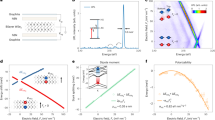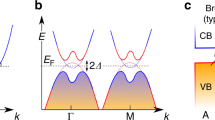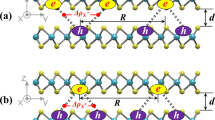Abstract
Exciton condensates (ECs) are macroscopic coherent states arising from condensation of electron–hole pairs1. Bilayer heterostructures, consisting of two-dimensional electron and hole layers separated by a tunnel barrier, provide a versatile platform to realize and study ECs2,3,4. The tunnel barrier suppresses recombination, yielding long-lived excitons5,6,7,8,9,10. However, this separation also reduces interlayer Coulomb interactions, limiting the exciton binding strength. Here, we report the observation of ECs in naturally occurring 2H-stacked bilayer WSe2. In this system, the intrinsic spin–valley structure suppresses interlayer tunnelling even when the separation is reduced to the atomic limit, providing access to a previously unattainable regime of strong interlayer coupling. Using capacitance spectroscopy, we investigate magneto-ECs, formed when partially filled Landau levels couple between the layers. We find that the strong-coupling ECs show dramatically different behaviour compared with previous reports, including an unanticipated variation of EC robustness with the orbital number, and find evidence for a transition between two types of low-energy charged excitations. Our results provide a demonstration of tuning EC properties by varying the constituent single-particle wavefunctions.
This is a preview of subscription content, access via your institution
Access options
Access Nature and 54 other Nature Portfolio journals
Get Nature+, our best-value online-access subscription
$29.99 / 30 days
cancel any time
Subscribe to this journal
Receive 12 print issues and online access
$259.00 per year
only $21.58 per issue
Buy this article
- Purchase on Springer Link
- Instant access to full article PDF
Prices may be subject to local taxes which are calculated during checkout




Similar content being viewed by others
Data availability
Experimental data relevant to figures in the main text and data of numerical calculations are available at https://doi.org/10.5281/zenodo.6377084. All other raw data are available from the corresponding author upon reasonable request.
References
Blatt, J. M., Böer, K. W. & Brandt, W. Bose-Einstein condensation of excitons. Phys. Rev. 126, 1691–1692 (1962).
Lozovik, Y. E. & Yudson, V. Feasibility of superfluidity of paired spatially separated electrons and holes; a new superconductivity mechanism. JETP Lett. 22, 274–276 (1975).
Snoke, D. Spontaneous Bose coherence of excitons and polaritons. Science 298, 1368–1372 (2002).
Eisenstein, J. P. & MacDonald, A. H. Bose–Einstein condensation of excitons in bilayer electron systems. Nature 432, 691–694 (2004).
Butov, L. V., Gossard, A. C. & Chemla, D. S. Macroscopically ordered state in an exciton system. Nature 418, 751–754 (2002).
Eisenstein, J. P. Exciton condensation in bilayer quantum Hall systems. Annu. Rev. Condens. Matter Phys. 5, 159–181 (2014).
Liu, X., Taniguchi, T., Watanabe, K., Halperin, B. & Kim, P. Quantum Hall drag of exciton condensate in graphene. Nat. Phys. 13, 746–750 (2017).
Li, J. I. A., Taniguchi, T., Watanabe, K., Hone, J. & Dean, C. R. Excitonic superfluid phase in double bilayer graphene. Nat. Phys. 13, 751–755 (2017).
Wang, Z. et al. Evidence of high-temperature exciton condensation in two-dimensional atomic double layers. Nature 574, 76–80 (2019).
Ma, L. et al. Strongly correlated excitonic insulator in atomic double layers. Nature 598, 585–589 (2021).
Halperin, B. I. & Rice, T. M. Possible anomalies at a semimetal-semiconductor transistion. Rev. Mod. Phys. 40, 755–766 (1968).
Lu, Y. F. et al. Zero-gap semiconductor to excitonic insulator transition in Ta2NiSe5. Nat. Commun. 8, 14408 (2017).
Kogar, A. et al. Signatures of exciton condensation in a transition metal dichalcogenide. Science 358, 1314–1317 (2017).
Li, Z. et al. Possible excitonic insulating phase in quantum-confined Sb nanoflakes. Nano Lett. 19, 4960–4964 (2019).
Jia, Y. et al. Evidence for a monolayer excitonic insulator. Nat. Phys 18, 87–93 (2022).
Ataei, S. S., Varsano, D., Molinari, E. & Rontani, M. Evidence of ideal excitonic insulator in bulk MoS2 under pressure. Proc. Natl Acad. Sci. USA 118, e2010110118 (2021).
Baldini, E. et al. The spontaneous symmetry breaking in Ta2NiSe5 is structural in nature. Preprint at arXiv https://doi.org/10.48550/arXiv.2007.02909 (2020).
Mazza, G. et al. Nature of symmetry breaking at the excitonic insulator transition: Ta2NiSe5. Phys. Rev. Lett. 124, 197601 (2020).
Butov, L. Condensation and pattern formation in cold exciton gases in coupled quantum wells. J. Phys. Condens. Matter 16, R1577 (2004).
Min, H., Bistritzer, R., Su, J.-J. & MacDonald, A. H. Room-temperature superfluidity in graphene bilayers. Phys. Rev. B 78, 121401 (2008).
Fogler, M. M., Butov, L. V. & Novoselov, K. S. High-temperature superfluidity with indirect excitons in van der Waals heterostructures. Nat. Commun. 5, 4555 (2014).
Jauregui, L. A. et al. Electrical control of interlayer exciton dynamics in atomically thin heterostructures. Science 366, 870–875 (2019).
Nandi, D., Finck, A. D. K., Eisenstein, J. P., Pfeiffer, L. N. & West, K. W. Exciton condensation and perfect Coulomb drag. Nature 488, 481–484 (2012).
Liu, X. et al. Crossover between strongly coupled and weakly coupled exciton superfluids. Science 375, 205–209 (2022).
Kim, Y., Moon, P., Watanabe, K., Taniguchi, T. & Smet, J. H. Odd integer quantum Hall states with interlayer coherence in twisted bilayer graphene. Nano Lett. 21, 4249–4254 (2021).
Gong, Z. et al. Magnetoelectric effects and valley-controlled spin quantum gates in transition metal dichalcogenide bilayers. Nat. Commun. 4, 2053 (2013).
Zeng, H. et al. Optical signature of symmetry variations and spin-valley coupling in atomically thin tungsten dichalcogenides. Sci. Rep. 3, 1608 (2013).
Xu, X., Yao, W., Xiao, D. & Heinz, T. F. Spin and pseudospins in layered transition metal dichalcogenides. Nat. Phys. 10, 343–350 (2014).
Fallahazad, B. et al. Shubnikov–de Haas oscillations of high-mobility holes in monolayer and bilayer WSe2: Landau level degeneracy, effective mass, and negative compressibility. Phys. Rev. Lett. 116, 086601 (2016).
Pisoni, R. et al. Absence of interlayer tunnel coupling of k-valley electrons in bilayer MoS2. Phys. Rev. Lett. 123, 117702 (2019).
Shi, Q. et al. Odd- and even-denominator fractional quantum Hall states in monolayer WSe2. Nat. Nanotechnol. 15, 569–573 (2020).
Young, A. F. & Levitov, L. S. Capacitance of graphene bilayer as a probe of layer-specific properties. Phys. Rev. B 84, 085441 (2011).
Zibrov, A. A. et al. Tunable interacting composite fermion phases in a half-filled bilayer-graphene Landau level. Nature 549, 360–364 (2017).
Li, J. I. A. et al. Pairing states of composite fermions in double-layer graphene. Nat. Phys. 15, 898–903 (2019).
Moon, K. et al. Spontaneous interlayer coherence in double-layer quantum Hall systems: charged vortices and Kosterlitz-Thouless phase transitions. Phys. Rev. B 51, 5138–5170 (1995).
Sondhi, S. L., Karlhede, A., Kivelson, S. A. & Rezayi, E. H. Skyrmions and the crossover from the integer to fractional quantum Hall effect at small Zeeman energies. Phys. Rev. B 47, 16419–16426 (1993).
Wu, X.-G. & Sondhi, S. L. Skyrmions in higher Landau levels. Phys. Rev. B 51, 14725–14728 (1995).
Zhang, Y.-H., Sheng, D. N. & Vishwanath, A. SU(4) chiral spin liquid, exciton supersolid, and electric detection in moiré bilayers. Phys. Rev. Lett. 127, 247701 (2021).
Acknowledgements
We thank E. Tutuc for helpful discussions and W. Coniglio and B. Pullum for help with experiments at the National High Magnetic Field Lab. This research is primarily supported by the US Department of Energy (DE-SC0016703). Synthesis of WSe2 (D.R., B.K., K.B.) was supported by the Columbia University Materials Science and Engineering Research Center, through National Science Foundation grants DMR-1420634 and DMR-2011738. A portion of this work was performed at the National High Magnetic Field Laboratory, which is supported by National Science Foundation cooperative agreement no. DMR-1157490 and the State of Florida. D.A.A. acknowledges support by the Swiss National Science Foundation and by the European Research Council (grant agreement no. 864597). Z.P. acknowledges support by the Leverhulme Trust Research Leadership Award RL-2019-015. K.W. and T.T. acknowledge support from the Elemental Strategy Initiative conducted by the Ministry of Education, Culture, Sports, Science and Technology, Japan (grant no. JPMXP0112101001) and Japan Society for the Promotion of Science KAKENHI (grant nos JP19H05790 and JP20H00354).
Author information
Authors and Affiliations
Contributions
Q.S. fabricated the devices, performed the capacitance measurements and analysed the data. E.-M.S. fabricated devices and performed transport measurements that complement the capacitance data. Z.P. and D.A.A. provided theoretical input and performed the numerical calculations. D.R. and B.K. grew the WSe2 crystals under the supervision of J.H. and K.B.; K.W. and T.T. grew the hexagonal boron nitride crystals. Q.S., C.R.D., J.H., Z.P. and D.A.A. wrote the manuscript with input from all authors.
Corresponding author
Ethics declarations
Competing interests
The authors declare no competing interests.
Peer review
Peer review information
Nature Nanotechnology thanks Liang Fu and the other, anonymous, reviewer(s) for their contribution to the peer review of this work.
Additional information
Publisher’s note Springer Nature remains neutral with regard to jurisdictional claims in published maps and institutional affiliations.
Supplementary information
Supplementary Information
Supplementary Discussion including figures.
Rights and permissions
About this article
Cite this article
Shi, Q., Shih, EM., Rhodes, D. et al. Bilayer WSe2 as a natural platform for interlayer exciton condensates in the strong coupling limit. Nat. Nanotechnol. 17, 577–582 (2022). https://doi.org/10.1038/s41565-022-01104-5
Received:
Accepted:
Published:
Issue Date:
DOI: https://doi.org/10.1038/s41565-022-01104-5
This article is cited by
-
Engineering interlayer hybridization in van der Waals bilayers
Nature Reviews Materials (2024)
-
Excitons stabilize above the band gap in bilayer WSe2
Nature Nanotechnology (2024)
-
Ultraviolet interlayer excitons in bilayer WSe2
Nature Nanotechnology (2024)
-
Remote imprinting of moiré lattices
Nature Materials (2024)
-
Interlayer exciton dynamics of transition metal dichalcogenide heterostructures under electric fields
Nano Research (2024)



